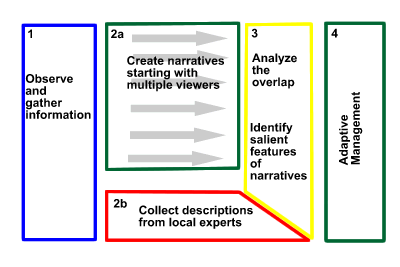Week 10
|
Overview
- Solving environmental problems
- MPF
- innovation
- small scale - entrepreneurism
- Integrative review
- course evaluation forms (10 to 15 minutes)
|
1. Lecture notes |
A. review MPF
Purpose: to gather broad input, aggressively pluralistic approach to the problem definition
Should help to avoid traps and suprises
Allows diverse teams to address the problem
- diverse skills (instrumental diversity)
- diverse values (fundamental preference diversity)
- Page's superadditivity principle
- a diverse team will beat an individual specialist/high-performer ($$$)
- Authentic problem will bring the team together

|
B. Innovation
|
B1. What drives the need for innovation?
The problems that we face are:
- complex (multiple parts)
- example: many different people with different views interacting to address a problem
- human control
- > 50% of the Earth's primary productivity is controlled by humans
- can't rely on the resiliency or buffering of nature
- tipping points - thresholds
Homer-Dixon calls this problem the "Ingenuity Gap"
New problems of our own making, such as
Old problems with new dimensions
- firewood, competition for biofuel, respiratory diseases
|
B2. Innovation includes technology AND institutions
new technologies or ways of using energy
- solar panels in the neighborhood
- batteries
- switches for managing load, putting power on the grid, local storage
require new institutions/organizations
- "Smart Grid"
- localized power
with willing customers/suppliers
- batteries
- such as plug in EV
- banks of batteries in a warehous
- cooperation by industries
- turn off power or reduce consumption during peak load
- contract for power costs that is mutually beneficial
|
B3. Example of "combinatorial" innovation
|
C. Taking action, with small scale entrepreneurial action
|
C1. Sometimes small scale actions are more effective
entrepreneurism can step in when there is a failure of the government or market to meet the needs of people
may be specific requirements
- unique local geographic or social conditions
- unique local requirements
- craft rather than industry approach
may be more effective because individuals are involved
- many people doing specific tasks
may be financially effective
- decreased power used to control the processes
- power goes up exponentially to control larger operations (Adams)
- decreased logistic costs
- decreased medium-term risk
- as compared to large projects
- sawtooth of payment and return rather than one big payment (Lovins)
may be better just because problems with large alternatives
|
C2. Examples
ecosystem restoration that relies on removing invasives
small, distributed power plants that are brought on-line as demand grows
demographic transition - fertility phase (compared to mortality phase which could be from a larger scale public works project)
|
C3. Operationally - what works
keystone species examples
- elephants knocking down trees - intermediate disturbance
- alligators creating wallows
- bats dispersing seeds for mangroves
operation principles
- look at overall rules of the system
- near tipping point or at the very least, positive feedback
- control with requisite complexity (match control system to controlled system)
manage for health and resilience
- best opportunities are development, not reclaimation
- eco-tipping points
- system builds itself back to health with minimum intervention
examples:
- marine reserves that preserve biodiversity and increase fisheries yield
- early season control by daphnia, may eliminate blooms (graph)
- marsh spreading with ILP (picture)
- organizing social movement through small groups (participation-threshold)
|
D. What can we do? (Review) - this will be the focus of assessment 10
- IPAT
- Everything is connected
- positive and negative feedback
- accounting to support decisions
- address risk and uncertainty in the future
- understanding worldviews
|
I=PAT
- interaction between these components
- higher affluence (spend more) to have less impact
- create wealth that is better for the environment
Everything is connected
Positive and negative feedback
Accounting to support decisions
Address risk and uncertainty in the future
Understand worldviews
Multiple perpectives
- include values from the beginning
- rigorous intellectual tools
- identify unintended consequences, embedded resources
- be careful to avoid thresholds for downward spiral
Innovation and Entrepreneurism may be required
- technology AND institutions
- appropriate risk and rewards that allow individuals to benefit from innovations
- permission to learn from mistakes
|
| |
| |


![]()